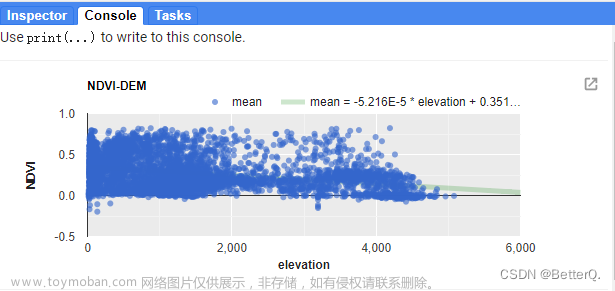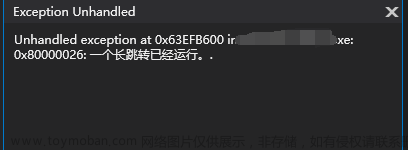问题:
// I don't know if some standard value exists for the radius, in the same, I will assume that some software would prefer to use square shape, but circle makes more sense to me.
// pixels is noice if you want to zoom in and out to visualize, but maybe for export or computation you would prefer meters
// 我不知道半径是否有标准值,同样,我认为有些软件更倾向于使用正方形,但我认为圆形更合理。
// 如果你想放大或缩小以进行可视化,像素是不错的选择,但对于导出或计算,你可能更倾向于使用米。
很多时候你也会遇到这种情况,当我们对于加载后的影像出现无法展示或者其它一些可视化的问题时,就会出现上面的状况。
解决方案:
影像可视化范围应根据缩放级别进行调整,如果放大,平均区域显然会变小,差异也会变小。
本文的TPI指数的展示过程中出现的错误,其中TPI具体指
TPI指地形坡度指数(Topographic Position Index),它是一种用于描述地表地形的指数。TPI指数可以通过计算某一点周围区域的高程值来得出,其值代表了该点相对于周围区域的高度位置。TPI指数可以用于研究地形对生态系统和水文循环等方面的影响,也可以用于进行地貌分析和地形分类。
TPI地形指数在地貌分析和地形分类中具有以下作用:
1. 地形分类:TPI指数可以帮助将地表地形划分为不同的类别,如凹地、山脊、平原等。通过对TPI值的分析,可以更好地理解地形特征和地貌类型。
2. 地貌分析:TPI指数可以提供关于地表地形的详细信息,如坡度、地势起伏等。这些信息对于环境评估、土地利用规划和自然资源管理等方面非常重要。
3. 生态系统研究:TPI指数可以用于研究地形对生态系统的影响。不同的地形类型可能具有不同的水文条件、土壤类型和植被分布,因此TPI指数可以帮助揭示地形与生态系统之间的关联性。
4. 水文循环:TPI指数可以用于研究地形对水文循环的影响。高TPI值的区域可能具有较高的坡度和水流速度,可能对降雨径流和水资源分配产生重要影响。
总之,TPI地形指数在地貌学、生态学、水文学等领域中具有广泛的应用,可以提供对地表地形特征和其对环境和生态系统的影响的深入理解。文章来源:https://www.toymoban.com/news/detail-715328.html
代码:
//COPERNICUS 加载可视化参数和研究区域
var imageVisParam = {"opacity":1,"bands":["classification"],"min":0,"max":6,"palette":["a3e657","7fb543","5c8231","09570e","e09435","cd6fff","cc0e3a"]},
geometry =
/* color: #98ff00 */
/* shown: false */
/* displayProperties: [
{
"type": "rectangle"
}
] */
ee.Geometry.Polygon(
[[[101.65166678243405, 72.74142473849005],
[101.65166678243405, 50.79933635280348],
[190.24541678243406, 50.79933635280348],
[190.24541678243406, 72.74142473849005]]], null, false),
Plots3 = ee.FeatureCollection("users/leaenguehard/Plots3"),
RF_Entire_Area = ee.Image("users/leaenguehard/RF_Entire_Area"),
geometry2 =
/* color: #98ff00 */
/* shown: false */
/* displayProperties: [
{
"type": "rectangle"
}
] */
ee.Geometry.Polygon(
[[[129.39412494682568, 65.42449957439194],
[129.39412494682568, 64.53241214116831],
[131.67928119682568, 64.53241214116831],
[131.67928119682568, 65.42449957439194]]], null, false);
// 加载DEM数据
var dataset = ee.ImageCollection('COPERNICUS/DEM/GLO30').filterBounds(geometry);
var elevationVis = {
min: 0.0,
max: 2500.0,
palette: ['0000ff','00ffff','ffff00','ff0000','ffffff'],
};
var elevation = dataset.select('DEM')
// 计算坡度坡向
var calculateSlopeAspect = function(image) {
// Compute slope and aspect
var slope = ee.Terrain.slope(image);
var aspect = ee.Terrain.aspect(image);
// Return the image with new bands for slope and aspect
return image.addBands(slope.rename('slope')).addBands(aspect.rename('aspect'));
};
elevation=ee.Join.saveAll("match").apply(elevation,elevation,ee.Filter.withinDistance({distance:300, leftField:'.geo', rightField: '.geo', maxError:100}))
elevation=ee.ImageCollection(elevation).map(function(im){
var extendedIM=ee.ImageCollection(ee.List(im.get("match"))).mosaic().setDefaultProjection(im.projection())
return calculateSlopeAspect(extendedIM).clip(im.geometry())
})
elevation=elevation.mosaic()
// 可视化图层
Map.addLayer(elevation.select('DEM'), elevationVis, 'DEM mosaic');
Map.addLayer(elevation.select('slope'), {min: 0, max: 45, palette: ['blue', 'green', 'yellow', 'orange', 'red']}, 'Slope');
Map.addLayer(elevation.select('aspect'), {min: 0, max: 360, palette: ['blue', 'cyan', 'green', 'yellow', 'orange', 'red']}, 'Aspect');
// 打印影像结果
print('Number of copernicus Images:', dataset.size());
print(elevation)
//进行核函数聚类处理的TPI指数
var TPI=elevation.select('DEM').subtract(elevation.select('DEM').convolve(ee.Kernel.circle(50,"pixels")))
//调整范围
Map.addLayer(TPI, {min: -250, max: 250, palette: ['blue', 'yellow','red']}, 'TPI')
 文章来源地址https://www.toymoban.com/news/detail-715328.html
文章来源地址https://www.toymoban.com/news/detail-715328.html
到了这里,关于GEE错误——影像加载过程中出现的图层无法展示的解决方案的文章就介绍完了。如果您还想了解更多内容,请在右上角搜索TOY模板网以前的文章或继续浏览下面的相关文章,希望大家以后多多支持TOY模板网!












